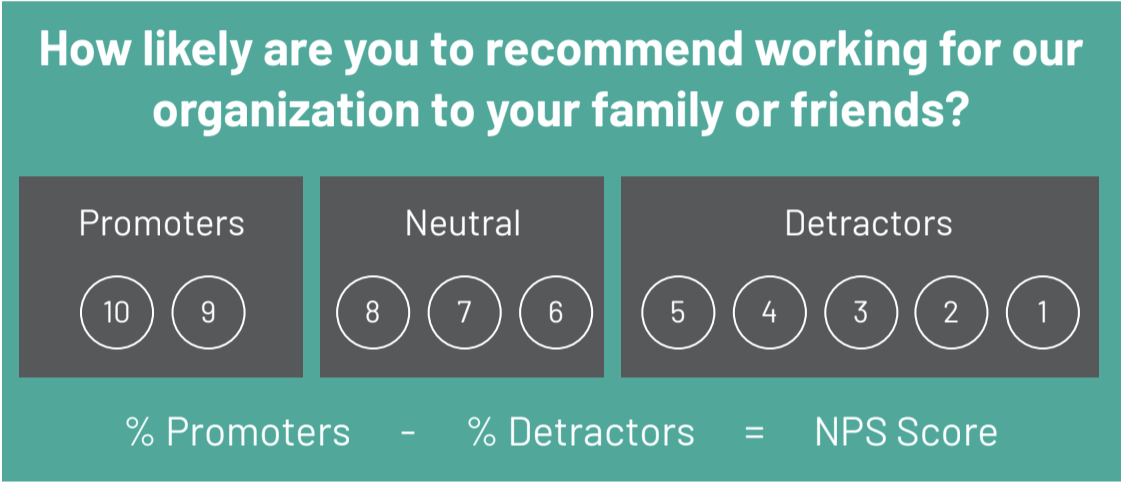Measuring Remote Employee Engagement with eNPS
“Our people are our most important resource.”
For a phrase so often mentioned, why do so many organizations still suffer from disengaged workers and high turnover? How can leaders ignore their greatest asset?
Simply put, while leaders know the importance of engaged employees, evaluating employee motivation can be a lot more challenging than measuring other more tangible assets. Yet as Verne Harnish, author of Scaling Up says, “Measuring their happiness is a way of making them tangible.” When done correctly, this measurement can be one of the best leading indicators of a company’s overall health and value.
In this post, we’ll break down a tried and true measurement of employee engagement and happiness: the eNPS (Employee Net Promoter Score).
Rather than ask employees about their overall satisfaction with their company, eNPS focuses on cultivating employee advocacy with one simple question: “On a scale from 0-10 how likely are you to recommend working for our organization to your family or friends?”
By turning engagement into a tangible metric, eNPS provides a method for quantifying engagement over time, helping leaders identify where efforts need to be made to improve team culture. Implementing a consistent eNPS survey can not only unveil areas for progress but also develop a culture of feedback in an organization where people feel comfortable expressing themselves freely.
About eNPS
eNPS is a spin-off of the widely used NPS (Net Promoter Score), first introduced by Fred Reichheld and Bain in their 2003 HBR Article “The One Number You Need to Grow”. The power of NPS, they said, lay in its ability to capture customer likelihood of marketing and promoting a product or brand to their friends in a single number.
In the product world, NPS has emerged as the dominant metric for measuring customer experience because it simplifies customer experience surveys into a single actionable question.
eNPS serves an identical function. It’s one number, tracked over time, with clear actionable insight into trends in employee engagement.
Calculating eNPS
While eNPS asks for a 1-10 score, the calculation of eNPS score goes beyond a simple average to give insight into overall satisfaction.

As the graphic above shows, the eNPS weighs scores to give an overall picture of the satisfaction of your employees. While all sorts of factors may determine where employees rank themselves numerically, the categories help leaders assess the overall health of their people.
Promoters are highly engaged employees, likely willing to go above and beyond to move the company forward.
Passives may be satisfied in their jobs, but may not extend themselves beyond what is expected.
Finally, Detractors may be disengaged or willfully shirking responsibility due to a lack of motivation.
Taken together, eNPS represents percentage promoters minus percentage detractors (a true Net Promoter Score).
So, the two ways to improve eNPS metrics over time are:
1. Turning Detractors into Passives
Before detractors can become promoters, they usually need to pass through the passive stage. For eNPS, addressing detractors is critically important. While an NPS detractor for a product or service may simply bring their business elsewhere, eNPS detractors may not feel motivated to perform
2. Turning Passives into Promoters
Leaders who value a culture where employees go above and beyond will want to focus efforts on turning passives into promoters. Investing in transparency, accountability, and better communication to improve team culture is a start. Initiating team-building activities and incentive-based rewards may also help. But cultivating truly intrinsic motivation in employees requires a personal touch and an active engagement with employees more than anything.
Why Use eNPS

The beauty of eNPS is in its simplicity and its consistency: the same question on a regular basis. Employees understand what is being asked and can set their own reference points. This enables comparisons and trend identification over time. By setting a baseline, leadership can better understand their impact
Critical in implementing eNPS effectively is ensuring that management carves out bandwidth to act on feedback quickly. Demonstrating a commitment to respond to employee suggestions and make changes to improve eNPS closes the essential feedback loop.
Managers should designate time in regular management meetings to discuss eNPS feedback Companies with sagging eNPS scores may take actions like creating a cross-functional team focused on improving eNPS or create a strategic goal related to eNPS.
eNPS should be considered as important, if not more so, than other critical leading indicators for your business. Every other metric will suffer if your employees are disengaged. Making efforts to monitor and improve eNPS can unlock the hidden potential of the people in your organization.
Measuring Remote Team Engagement
In an era where employees may be permanently working from home, leaders must increase emphasis on process to assess employee engagement. The cues leaders may have used to evaluate employee motivation in the past, like body language, won’t translate to a remote team. Recreating the impromptu support we might give to a coworker looking distressed in the office takes intentional effort.
We live in a time of heightened anxiety. As our homes become our offices, the stress of our work, our families, and the world at large becomes hopelessly entangled. Leaders of organizations have a duty to support their employees during this time and protect their most valuable assets.
eNPS serves as a temperature check for leaders looking to understand how changes like working from home are affecting employee engagement. Beyond driving profits and business objectives, eNPS measures how leaders are doing in their most important job function: providing purpose and rewarding, meaningful work for their employees.
Learn more about managing engagement on your remote team!




